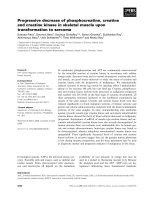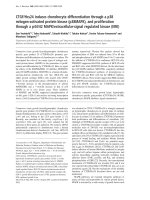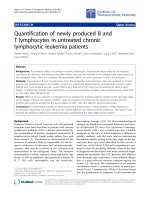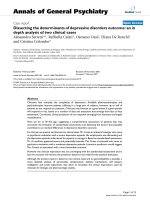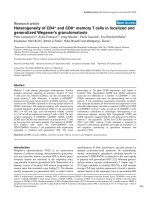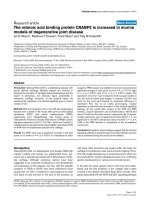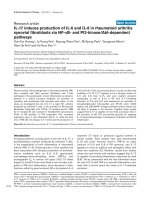Báo cáo y học: "Dasatinib preferentially induces apoptosis by inhibiting Lyn kinase in nilotinib-resistant chronic myeloid leukemia cell line" pot
Bạn đang xem bản rút gọn của tài liệu. Xem và tải ngay bản đầy đủ của tài liệu tại đây (507.09 KB, 3 trang )
LET T E R TO THE EDITOR Open Access
Dasatinib preferentially induces apoptosis by
inhibiting Lyn kinase in nilotinib-resistant chronic
myeloid leukemia cell line
Seiichi Okabe
*
, Tetsuzo Tauchi, Yuko Tanaka and Kazuma Ohyashiki
Abstract
Nilotinib is approved for treatment of newly diagnosed chronic myeloid leukemia (CML) and it is shown superiority
over imatinib in first-line treatment for patients of CML. In this study, we established a nilotinib-resistant cell line,
K562NR, and evaluated the resistance to nilotinib and efficacy of dasatinib. We found activation of Lyn plays a
dominant role in survival of the nilotinib-resistant cell line. We found dasatinib induces the apoptosis of nilotinib-
resistant cells and inhibits Lyn kinase activity. This novel nilotinib-resistant CML cell line may help to explore novel
therapy for CML.
To the editor
The BCR/ABL kinase inhibitor, imatinib, is the single
effective and the standard treatment for chronic myeloid
leukemia (CML) [1]. Resistance to imatinib is now a
problem clinically. Imatinib resistance is often attributed
to the emergence of clones expressing the BCR/ABL
mutat ion and several other mechanisms such as overex-
pression of BCR/ABL and activation of Src-r elated
kinase [2]. Nilotinib (AMN107) is a new BCR/ABL inhi-
bitor and is highly selective for ABL kinase and 30-fold
more potent than imatinib. Nilotinib has produced
hematological and cytogenetic responses in CML
patients, who did not initially respond to imatinib or
developed imatinib resistance [3]. Recently, in Evaluating
Nilotinib Efficacy and Safety in clinical Trials-newly
diagnosed CML (ENESTnd), nilotinib has shown super-
ior efficacy as front line treatment for patients with
CML-chronic phase (CP) in comparison with imatinib
[4,5]. Although nilo tinib has shown superiority over
imatinib in first-line treatment for CML-CP patients,
the management of CML f ollowing the development of
nilotinib resistance remains a challenge. In this study,
we established a nilotinib-resistant cell line, K562NR,
and evaluated the resistance to and efficacy of dasatinib.
BCR/ABL levels were not increased by fluorescence in
situ hybridization (FISH) analysis (data not shown).
K562NR cells had no point mutation in Abl kinase (data
not shown). K562 NR cells were resistant to high con-
centrations of nilotinib, with the IC50 being more than
10 μM (Figure 1A). Dasatinib (BMS-354825), a second
generation tyrosine kinase inhibitor, is another promis-
ing new clinical candidate for CML treatment and has
also shown good efficacy in CML patie nts, including
imatinib-resista nt cases. Dasatinib is an effective therapy
after imatinib and nilotinib therapy failure in CML
patients [6]. The phase III dasatinib versus imatinib
study in treatment-naïve CML patients (DASISION)
study demonstrates superior efficacy of dasatinib over
imatinib and an acceptable safety profile [5,7]. We
found that dasatinib reduced the cell growth of K562NR
and significantly induced apoptosis. The IC50 of dasati-
nib is 5 nM (Figure 1A). We found that K562NR cells
underwent increased phosphorylation of Src family
kinase (SFK) including Lyn (Figure 1B). Phosphorylation
of SFK was reduced after 24-hrs dasatinib treatment in
a dose-dependent manner. Cleaved caspase 3 and poly
(ADP-ribose) polymerase (PARP) were detected after
24-hrs dasatinib treatment (Figure 1B). We noted that
protein levels o f p21 increased and cyclin D1 was
reduced after dasatinib treatment (Figure 1B). In our
experiment, dasatinib also potentially induced apoptosis
of the nilotinib-resistant cell line. Dasatinib was effective
in 13 of the 23 patients with CML after imatinib and
nil otinib therapy failure, including 7 patients who had a
* Correspondence:
First Department of Internal Medicine, Tokyo Medical University, 6-7-1 Nishi-
shinjuku, Shinjuku-ku, Tokyo 160-0023, Japan
Okabe et al. Journal of Hematology & Oncology 2011, 4:32
/>JOURNAL OF HEMATOLOGY
& ONCOLOGY
© 2011 Okabe et al; licensee BioMed Central Ltd. This is a n Open Access article distributed under the terms of the Creative Commons
Attribution License ( ), which permits unrestricted use, distributio n, and reproduction in
any medium, provided the original work is prop erly cited.
cytogenetic response [6]. These patients exhibited sev-
eral Abl kinase mutations such as E255V/K. The resis-
tance to imatinib in BCR/ABL positive cells has been
reported to be associated with the activation of PI3K/
AKT1 pathways [8]. In this study, there was no muta-
tion in Abl kinase, but Src family kinases, including Lyn,
was activated in the nilotinib-resistant cell line. Lyn
kinase has been previously shown to be an important
component in cytokine signal transduction, and is also
reported to play a role in the growth and apoptotic reg-
ulation of hematopoietic cells [9]. Activation of SFK
including Lyn may play a dominant role in the prolifera-
tion and survival of the nilotinib-resistant cell line, and
the reduction of SFK pho sphorylation may act at the
p21 and cyclin D1 level and induce the apoptosis of
K562NR cells after dasatinib treatment. This study
Figure 1 Cell growth inhibition by dasatinib and cellular signaling in a nilo tinib resistant cell line. (A) K562NR cells exposed to dasatinib
or nilotinib for 72-hrs were quantitated by cell proliferation. Each result is presented as the mean percentage of proliferation of unexposed
control cultures. (B) Phosphorylation of Lyn, Src, cleaved caspase 3, PARP, p21, cyclin D1, and actin levels were analyzed by immunoblotting
using the protein (30 μg) from cell lysates.
Okabe et al. Journal of Hematology & Oncology 2011, 4:32
/>Page 2 of 3
showed that secondary signaling events involving SFK/
Lyn in a nilotinib-resistant CML cell line may play a sig-
nificant role for in the resistant mechanism.
List of abbreviations
CML: chronic myeloid leukemia; CP: chronic phase; ENESTnd: evaluating
nilotinib efficacy and safety in clinical trials-newly diagnosed CML; FISH:
fluorescence in situ hybridization; DASISION: dasatinib versus imatinib study
in treatment-naïve CML patients
Acknowledgements
We thank Novartis and Bristol-Myers Squibb for providing the compound.
This work was supported by a “High-Tech Research Center” Project for
private universities: matching fund subsidy from the ME XT (Ministry of
Education, Culture, Sports, Science and Technology), and by the “University-
Industry Joint Research Project” for private universities: matching fund
subsidy from the MEXT. This work was also supported by Grants-in-Aid for
Scientific Research from the MEXT.
Authors’ contributions
SO performed the experimental procedures; TT, YT and KO designed and
coordinated the study and interpreted data. All authors have read and
approved the final manuscript.
Conflicts of interests
The authors declare that they have no competing interests.
Received: 29 June 2011 Accepted: 2 August 2011
Published: 2 August 2011
References
1. Deininger M, Buchdunger E, Druker BJ: The development of imatinib as a
therapeutic agent for chronic myeloid leukemia. Blood 2005,
105:2640-2653.
2. Kantarjian HM, Talpaz M, Giles F, O’Brien S, Cortes J: New insights into the
pathophysiology of chronic myeloid leukemia and imatinib resistance.
Ann Intern Med 2006, 145:913-923.
3. Kantarjian H, Giles F, Wunderle L, Bhalla K, O’Brien S, Wassmann B, Tanaka C,
Manley P, Rae P, Mietlowski W, Bochinski K, Hochhaus A, Griffin JD,
Hoelzer D, Albitar M, Dugan M, Cortes J, Alland L, Ottmann OG: Nilotinib in
imatinib-resistant CML and Philadelphia chromosome-positive ALL. N
Engl J Med 2006, 354:2542-2551.
4. Saglio G, Kim DW, Issaragrisil S, le Coutre P, Etienne G, Lobo C, Pasquini R,
Clark RE, Hochhaus A, Hughes TP, Gallagher N, Hoenekopp A, Dong M,
Haque A, Larson RA, Kantarjian HM, ENESTnd Investigators: Nilotinib versus
imatinib for newly diagnosed chronic myeloid leukemia. N Engl J Med
2010, 362:2251-2259.
5. Wei G, Rafiyath S, Liu D: First-line treatment for chronic myeloid
leukemia: dasatinib, nilotinib, or imatinib. J Hematol Oncol 2010, 3:47.
6. Quintas-Cardama A, Kantarjian H, Jones D, Nicaise C, O’Brien S, Giles F,
Talpaz M, Cortes J: Dasatinib (BMS-354825) is active in Philadelphia
chromosome-positive chronic myelogenous leukemia after imatinib and
nilotinib (AMN107) therapy failure. Blood 2007, 109:497-499.
7. Kantarjian H, Shah NP, Hochhaus A, Cortes J, Shah S, Ayala M, Moiraghi B,
Shen Z, Mayer J, Pasquini R, Nakamae H, Huguet F, Boqué C, Chuah C,
Bleickardt E, Bradley-Garelik MB, Zhu C, Szatrowski T, Shapiro D,
Baccarani M: Dasatinib versus imatinib in newly diagnosed chronic-phase
chronic myeloid leukemia. N Engl J Med 2010, 362:2260-2270.
8. Quentmeier H, Eberth S, Romani J, Zaborski M, Drexler HG: BCR-ABL1-
independent PI3Kinase activation causing imatinib-resistance. J Hematol
Oncol 2011, 4:6.
9. O’Laughlin-Bunner B, Radosevic N, Taylor ML, DeBerry C, Metcalfe DD,
Zhou M, Lowell C, Linnekin D: Lyn is required for normal stem cell factor-
induced proliferation and chemotaxis of primary hematopoietic cells.
Blood 2001, 98:343-350.
doi:10.1186/1756-8722-4-32
Cite this article as: Okabe et al.: Dasatinib preferentially induces
apoptosis by inhibiting Lyn kinase in nilotinib-resistant chronic myeloid
leukemia cell line. Journal of Hemato logy & Oncology 2011 4:32.
Submit your next manuscript to BioMed Central
and take full advantage of:
• Convenient online submission
• Thorough peer review
• No space constraints or color figure charges
• Immediate publication on acceptance
• Inclusion in PubMed, CAS, Scopus and Google Scholar
• Research which is freely available for redistribution
Submit your manuscript at
www.biomedcentral.com/submit
Okabe et al. Journal of Hematology & Oncology 2011, 4:32
/>Page 3 of 3
